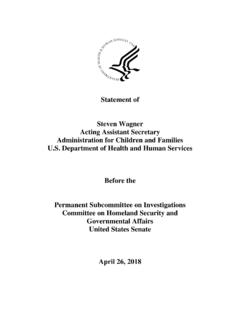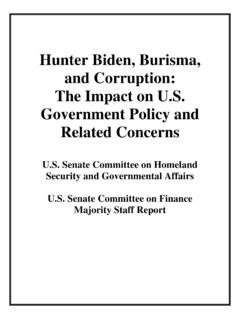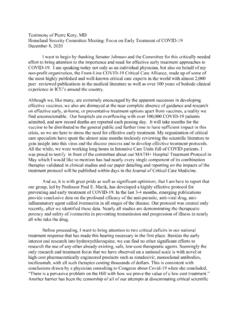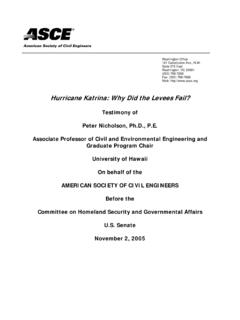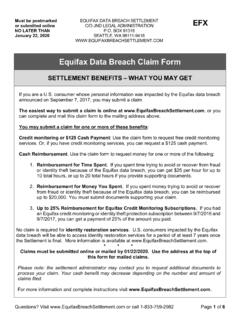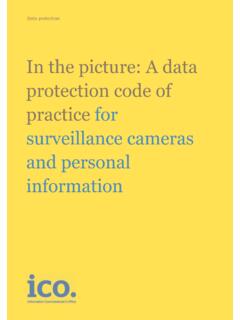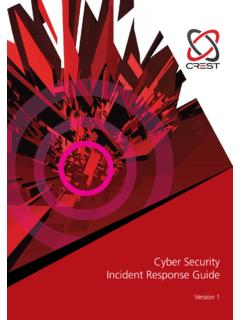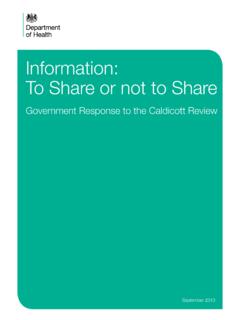Transcription of HOW EQUIFAX NEGLECTED CYBERSECURITY AND SUFFERED A ...
1 United States Senate PERMANENT SUBCOMMITTEE ON INVESTIGATIONS. Committee on Homeland Security and Governmental Affairs Rob Portman, Chairman Tom Carper, Ranking Member HOW EQUIFAX NEGLECTED CYBERSECURITY AND. SUFFERED A DEVASTATING data BREACH. STAFF REPORT. PERMANENT SUBCOMMITTEE ON INVESTIGATIONS. UNITED STATES SENATE. HOW EQUIFAX NEGLECTED CYBERSECURITY AND. SUFFERED A DEVASTATING data BREACH. TABLE OF CONTENTS. EXECUTIVE SUMMARY .. 1. The Subcommittee's Investigation .. 6. Findings of Fact and Recommendations .. 6. I. BACKGROUND .. 12. A. Consumer Reporting Agencies .. 14. 1. EQUIFAX .. 15. 2. Experian .. 15. 3. TransUnion .. 16. B. Federal Regulation of Consumer Reporting Agencies .. 16. C. The Federal Government's Role in Sharing Information on CYBERSECURITY Threats .. 18. D. data Breach Notification Standards .. 20. II. EQUIFAX WAS AWARE OF CYBERSECURITY WEAKNESSES FOR. 21. A. EQUIFAX Learned of Significant CYBERSECURITY Deficiencies in 2015.
2 21. 1. Purpose of the Audit .. 21. 2. The Audit Highlighted a Backlog of over 8,500 Vulnerabilities with Overdue Patches .. 22. 3. Key Audit Findings Demonstrate EQUIFAX 's Ineffective Patch and Configuration Management .. 23. a. EQUIFAX Did Not Follow Its Own Schedule for Remediating Vulnerabilities .. 24. b. EQUIFAX Lacked a Comprehensive IT Asset 25. c. EQUIFAX Had a Reactive Patching Process .. 25. d. EQUIFAX Used an Honor System for Patching .. 26. e. EQUIFAX Did Not Consider the Criticality of IT Assets When Patching .. 27. 4. EQUIFAX Conducted No Follow-Up Audits After the 2015 Audit .. 28. B. Patching Issues Remained Leading up to the Breach in 2017 .. 29. 1. EQUIFAX 's Scan Process Was Global; Patch Management Was Regional .. 29. 2. It Was Unclear Whether IT Was Following Patch Management and Vulnerability Management Procedures .. 30. 3. EQUIFAX Needed a New Scanning Tool .. 30. III. EQUIFAX 'S RESPONSE TO THE VULNERABILITY THAT FACILITATED.
3 THE BREACH WAS INADEQUATE AND HAMPERED BY ITS. NEGLECT OF CYBERSECURITY .. 31. A. The Tools Necessary to Exploit the March 2017 Apache Struts Vulnerability Were Publicly Available and Easy to Use .. 33. B. EQUIFAX Did Not Follow Its Patch Management Policy When Responding to the Apache Struts 35. 1. EQUIFAX 's Patch Management Policy Required the IT Department to Patch Critical Vulnerabilities Within 48 Hours .. 35. 2. EQUIFAX Did Not Patch the Apache Struts Vulnerability Until August 2017 .. 37. C. EQUIFAX Held Monthly Meetings to Discuss Threats and Vulnerabilities, but Follow-Up Was Limited and Key Senior Managers Did Not Attend .. 37. 1. EQUIFAX Highlighted the Apache Struts Vulnerability in Its March GTVM Meeting .. 38. 2. Prior to the Breach, Senior Managers from EQUIFAX Security Teams Did Not Regularly Participate in These Monthly Meetings .. 39. D. The EQUIFAX Employee Who Was Aware of EQUIFAX 's Use of Apache Struts Software Was Not on the Relevant Email Distribution List.
4 40. E. EQUIFAX Scanned Its Systems and Servers for the Vulnerable Versions of Apache Struts and Found No Vulnerability .. 41. F. Expired SSL Certificates Delayed EQUIFAX 's Ability to Detect the Breach for Months .. 43. G. Once Inside EQUIFAX 's Online Dispute Portal, the Hackers Accessed Other EQUIFAX 45. H. EQUIFAX Waited Six Weeks to Inform the Public of the 46. 1. Some Companies Have Disclosed data Breaches Days After Discovering Them .. 48. 2. Other Companies Made Public Disclosure Years Later or Simply Declined to Notify .. 50. I. Several Current and Former Senior EQUIFAX Employees Believe EQUIFAX Acted Appropriately in Responding to the Apache Struts Vulnerability .. 51. IV. EQUIFAX 'S LARGEST COMPETITORS, TRANSUNION AND EXPERIAN, WERE ABLE TO QUICKLY IDENTIFY WHERE THEY WERE RUNNING. VULNERABLE VERSIONS OF APACHE STRUTS AND PROACTIVELY. BEGAN PATCHING .. 55. A. CRAs Had Different Timelines for Patch 55. 1. TransUnion.
5 55. 2. Experian .. 56. B. CRAs Generally Performed Vulnerability Scans on a Regular Basis .. 57. 1. TransUnion .. 57. 2. Experian .. 58. C. Other CRAs Maintained an IT Asset Inventory .. 58. 1. TransUnion .. 58. 2. Experian .. 58. D. CRAs Lacked Written Policies for Tracking the Validity of SSL. Certificates .. 59. 1. TransUnion .. 59. 2. Experian .. 59. E. EQUIFAX 's Two Largest Competitors, TransUnion and Experian, Avoided a CYBERSECURITY Breach .. 60. 1. TransUnion .. 60. 2. Experian .. 61. V. EQUIFAX FAILED TO PRESERVE A COMPLETE RECORD OF. EVENTS SURROUNDING THE BREACH .. 62. A. EQUIFAX 's Document Retention Policy .. 63. 1. EQUIFAX 's Document Retention 63. 2. EQUIFAX 's Legal Hold Policy .. 64. B. EQUIFAX 's Use of Lync .. 65. C. EQUIFAX Employees Used Lync to Discuss Business Matters, Including Events Surrounding the 2017 data Breach .. 65. HOW EQUIFAX NEGLECTED CYBERSECURITY AND. SUFFERED A DEVASTATING data BREACH. EXECUTIVE SUMMARY.
6 The effects of data breaches are often long-lasting and challenging to reverse. Victims who have had their sensitive personal or financial information stolen by hackers can be left with years of expense and hassle. No type of entity or sector of the economy has been immune to data breaches. In 2018 alone, Google+, Facebook, Ticketfly, T-Mobile, Orbitz, Saks, Lord & Taylor, and Marriott all announced significant breaches. The importance of protecting personally identifiable information ( PII ) grows with every successive data breach. Consumers and businesses are well aware of the need to safeguard items like driver's licenses, credit cards, and financial records that criminals can use to their advantage. Consumers also understand the need to protect information like online passwords, pin numbers, and Social Security numbers. But a consumer taking appropriate care of this information may not be enough to keep PII out of the hands of criminal hackers.
7 In the modern world, businesses collect and compile data about their customers and potential customers. Without proper precautions, this information can be stored or transmitted in ways that leave it vulnerable to theft. The information collected by consumer reporting agencies ( CRAs ) to compile credit reports is one example of PII that must be protected. This information includes a consumer's name, nicknames, date of birth, Social Security number, telephone numbers, and current and former addresses. Credit reports also typically include a list of all open and closed credit accounts, account balances, account payment histories, and the names of creditors. The information tells the story of a consumer's financial life and can determine whether they can rent an apartment, buy a car, or qualify for a home loan. If stolen, criminals can use it to do significant financial harm. The steps CRAs take to safeguard consumers' credit histories are extremely important.
8 If that information is compromised, consumers should know to be on heightened alert to monitor their finances and mitigate any potential damage. In 2017, one of the largest CRAs, EQUIFAX Inc. ( EQUIFAX ) announced that it had SUFFERED a data breach that involved the PII of over 145 million Americans. The Subcommittee investigated the causes of this breach to identify ways to prevent future incidents of this scope. The Subcommittee also reviewed the efforts of EQUIFAX 's two largest competitors, Experian plc ( Experian ) and TransUnion LLC. ( TransUnion ), in responding to the vulnerability that ultimately led to the EQUIFAX data breach. Highlights of the Subcommittee's investigative results, including findings and recommendations, are provided below. EQUIFAX Failed to Prioritize CYBERSECURITY . EQUIFAX had no standalone written corporate policy governing the patching of known cyber vulnerabilities until 2015. After implementing this policy, EQUIFAX conducted an audit of its patch management efforts, which identified a backlog of over 8,500 known vulnerabilities that had not been patched.
9 This included more than 1,000 vulnerabilities the auditors deemed critical, high, or medium risks that were found on systems that could be accessed by individuals from outside of EQUIFAX 's information technology ( IT ) networks. The audit report concluded, among other things, that EQUIFAX did not abide by the schedule for addressing vulnerabilities mandated by its own patching policy. It also found that the company had a reactive approach to installing patches and used what the auditors called an honor system for patching that failed to ensure that patches were installed. The audit report also noted that EQUIFAX lacked a comprehensive IT asset inventory, meaning it lacked a complete understanding of the assets it owned. This made it difficult, if not impossible, for EQUIFAX to know if vulnerabilities existed on its networks. If a vulnerability cannot be found, it cannot be patched. EQUIFAX never conducted another audit after the 2015 audit and left several of the issues identified in the 2015 audit report unaddressed in the months leading up to the 2017 data breach.
10 EQUIFAX Could Not Follow Its Own Policies in Patching the Vulnerability That Ultimately Caused the Breach. EQUIFAX 's patching policy required the company's IT. department to patch critical vulnerabilities within 48 hours. The company's security staff learned of a critical vulnerability in certain versions of Apache Struts a widely-used piece of web application software on March 8, 2017, from the Computer Emergency Readiness Team at the Department of Homeland Security. The National Institute of Standards and Technology gave the vulnerability the highest criticality score possible; it was widely known that the vulnerability was easy to exploit. EQUIFAX employees circulated news of the vulnerability through an internal alert the next day that went to a list of more than 400 company employees. EQUIFAX held monthly meetings to discuss cyber threats and vulnerabilities, but senior managers did not routinely attend these meetings and follow-up was limited.
